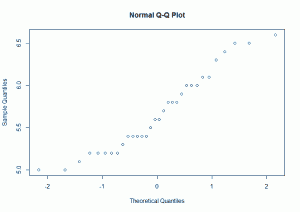 Once again, here’s the Monty Hall problem:
Once again, here’s the Monty Hall problem:
Monty Hall offers you a choice of three doors. Behind two are goats, and behind the other door is a brand new car. After you make your choice, Monty opens one of the doors you didn’t choose to reveal a goat, and offers you the chance to switch your choice to the one remaining. What should you do? (Assume Monty knows where the car is and always opens a door with a goat after the contestant chooses.)
- Switch
- Stay
- It doesn’t matter.
Many people think that once Monty opens a door to reveal a goat, that with only two doors remaining, their odds of winning the car are 50-50. That explains why many people think it doesn’t matter if you stay or switch. Some people think that perhaps Monty is trying to talk them out of sticking with their original door because it contains the car. These people are likely to think that staying with their first choice gives them better than 50-50 odds.
However, the correct way to think about this problem is that you had a 1/3 chance of guessing right on your first try. After Monty opens a door and reveals a goat, there’s still a 1/3 chance that you were right, which means there’s still a 2/3 chance that you were wrong. Before Monty opened that door, that 2/3 chance that the car was not behind your door was split between two doors. Now, however, there’s a 2/3 chance that the car is behind the remaining door that you didn’t choose. So you should switch. On average, you would expect to win a car 2/3 of the time if you switch.
Here’s the tree diagram I showed briefly in class. It helps to model this random process in something of a chronological order. First, the car is placed behind one of the three doors randomly, with each door being equally likely. Then, you select your door, again with each door being equally likely. Then, Monty opens one of the other doors to reveal a goat. (It’s important that Monty knows where the goats are here! Otherwise you get a different tree diagram.) When you look at the outcomes, not all are equally likely because Monty’s choices are limited in some cases. Of all the outcomes, weighted by their respective probabilities, your choice of door was correct only 1/3 of the time. Thus, switching doors is the better strategy.
Here’s another way to think about this: When you picked your door, you had a 1/3 chance of picking the door with the car. When Monty opens a door to reveal a goat, he’s giving you more information than you had originally. (Again, this assumes that Monty knows where the goats are.) When you get more information, you can improve on your initial 1/3 chance of winning. That’s why this is a conditional probability problem: Given information about one event (that one of the doors you didn’t choose has a goat behind it), the probability of another event (that you chose correctly) changes.
To hear what Monty Hall himself had to say about this problem, check out this New York Times interview. One thing made clear in that interview is that Monty did indeed know where the goats were. But, in contrast to the problem as I stated it above, he wasn’t required to always open a second door and offer contestants the chance to switch. If the contestant chose a door with a goat, Monty didn’t have to make any deals!
Image: “Goats Only,” by me



